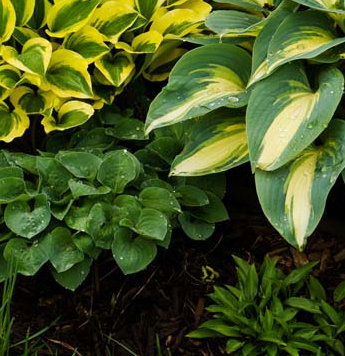
SUCESSFULLY GROW HOSTAS

Bed Prep
Hostas do their best in a moisture retentive and highly organic soil. To achieve this mix three inches of equal parts organic compost, manure and sphagnum peat moss should be added to every 6-8” of tilled soil. Feed your newly planted Hostas with a starter fertilizer blended around the roots. Mulch lightly, no more than 1-2”. Water regularly, preferably with a soaker hose.
Light Requirements
Although Hostas are synonymous with shade gardens, they all appreciate a ‘little’ sunshine, some more than others. Ideally, morning sun is best, since if left to fry in afternoon sun, Hosta will sunburn. Fragrant Hostas must have more sun in order to bloom well, one third of the day or more. Heavily shaded areas should be avoided, as this condition will impair your Hosta’s blooming period and size. The general rule is that blues prefer more shade while the variegated and solid greens tolerate more sun.
Spacing
Hostas come in six sizes. This table will give you an average width by size of a 6 to 10 year old plant and how far apart you should plant your Hostas.
| Size | Width | Distance Apart |
| Giant | 4 to 6’ | Plant 4-6’ apart |
| Large | 3 to 4’ | Plant 3-4’ apart |
| Medium | 2’ | Plant 2’ apart |
| Small | 1-2’ | Plant 18” –2’ apart |
| Miniature | 6-12” | Plant 15-18” apart |
| Dwarf | 3-6” | Plant 6-15” apart |
Companion Plantings
Trees – Roots of trees compete for available plant nutrients and moisture. Hostas planted under them have different requirements depending on the type of tree. Those with deep-rooted systems such as Oak, Linden or White Ash, require only that the bed around the tree base be amended. Hostas planted around trees with more invasive roots such as Maple, Sassafras, Locust will, in addition to the soil amendment, appreciate your building for them a raised bed in which to call home.
Perennials – Hostas mix beautifully with any number of perennials. If you are planning a shade garden, intermingle Hosta with Ferns, Astilbes, Chelone, Columbine, Bleeding Heart, or Primrose. Mix sun tolerant Hosta with Daylilies for a non-traditional look. Groundcovers of Vinca, Ajuga, Ginger, Epidediums or Soloman’s Seal combine to make an impressive perennial bed when planted with Hosta.
Pests and other Aggravations
The biggest insect problem facing Hostas are slugs. Ravenous feeders, slugs will lay a specimen Hosta to waste in no time. A chemical remedy such as “Bug-getta” or an earth friendly one such as “Diatomaceous Earth” can be used. Leaf spot may occur occasionally, but may be controlled with a fungicide.

